39 Best Hacks to Improve Email Deliverability & 15 Tools to Use
You’ve spent hours crafting the perfect email campaign. You carefully designed your email copy and layout to engage your subscribers. You even personalized your emails to appeal to your different audience segments. But when you finally hit send, you discover that your emails are going straight to spam. If you’ve ever experienced this situation, you know how email deliverability affects email marketing performance. Luckily, you can improve email deliverability to reach the right inbox consistently. This article will discuss the significance of email deliverability, help you identify factors that impact your email deliverability rates, and give you actionable tips to improve your performance.
Blocfree's email template builder can help you create high-performing emails that engage your audience and boost your email deliverability rates.
What Is Email Deliverability?

Email deliverability defines the rate at which your email makes it into recipient inboxes. An email deliverability rate can be lower when an email bounces or gets automatically filtered into a spam folder. Imagine you send mail to a friend with a missing sender name. The post could end up in the trash because of the unknown sender. Similarly, emails may get delivered to the recipient’s email address but in a spam or marketing folder.
Email Delivery vs. Email Deliverability
Email delivery measures the number of emails delivered successfully, regardless of the folder. It tells if the recipient’s mail server has accepted the email file and offered it to the receiver. It calculates the percentage of emails that didn’t bounce out of the sent emails. Email deliverability is akin to the number of emails that reach the right destination.
Also known as inbox placement, it calculates the percentage of emails that get delivered to the priority inbox. An email deliverability rate of 100 emails, out of which 33 were in the spam folder, is 66%. An accessible summary of this email delivery vs. email deliverability comparison is:
- Email delivery = How many emails were delivered?
- Email deliverability = How many emails were delivered to the recipient?
Delivery issues may be due to faulty email addresses, problems with your infrastructure, or too much negative feedback on the email address. Deliverability issues arise due to:
- Outdated sending and permission practices
- Violating a law
- Receiving too many spam labels by the receivers
Craft Stunning Emails with Blocfree
Create, share, and publish easily with Blocfree's email template builder. Blocfree is an email HTML editor that allows you to quickly create/edit emails and use it with multiple platforms like:
- Mailgun
- Sendgrid and others
Effortlessly craft email, SMS, and push templates with our intuitive email template builder. Collaborate seamlessly with your team and quickly publish content to your preferred platform.
Use Blocfree's email template builder for free today!
Related Reading
Interesting Statistics About Email Deliverability in 2024

Does Google Still Rule the World?
Google remains the most dominant email service provider (ESP) in 2024, boasting a solid 37% market share. This figure is down from 41% in late 2023, but Google is still the most popular ESP among GlockApps customers.
Did the Percentage of Senders Using Outlook Increase?
No, the percentage of senders using Outlook decreased from 13% in late 2023 to 12% in early 2024.
Is Mailgun as Popular as Before?
Not really. Mailgun's market share has decreased from 13% of senders in late 2023 to 10% in early 2024.
Email Deliverability in 2024: What the Stats Say
The average email deliverability rate in 2024 across multiple top email marketing platforms is 83%.
- EmailToolTester: More than 10% of emails were in subscribers’ spam folders.
- EmailTooltester: Approximately 1 in 6 marketing emails never reach the subscribers, and 20% of emails fail to reach the recipients' inboxes.
- Returnpath: A 95% or higher delivery rate is considered excellent.
- Omnisend: The industry-accepted benchmark for email bounce rate is 2%.
- MyEmma: Based on the respective engagement levels, 63% of businesses adjust the frequency of emails sent to subscribers.
- Databox: Spam complaints are the second most common reason for inbox placement issues, accounting for 21%.
- ReturnPath: Low mailbox usage is the main reason for a low inbox placement rate, contributing to 19% of such issues.
- ReturnPath: In September 2020, spam emails constituted 47.3% of total email traffic.
- Statista: Approximately 23% of an email list declined in quality each year.
- ZeroBounce: In 2019, the worldwide inbox placement rate was 83%, whereas the spam placement rate was 7%.
- Returnpath: Marketing emails generally exhibit a low engagement rate, with an open rate of 20-25%
- Hubspot: Email delivery rates have steadily increased over the last three years; the overall rate stood at 98.2%
- DotDigital: 17% of emails never reach your subscribers’ inboxes. (EmaillToolTester)
Email Open Rate Statistics
Global marketers across all industries reported an average email open rate of 46-50%.
- Hubspot: The average email open rate across the industry is 21% or above.
- Mailmunch: Government emails have the highest open rate (28.77%). Hobbies-related industries like photography, writing, and sketching have a 27.74% open rate. On the other hand, marketing and advertisement have an open rate of 17.38%. The average CTOR (click-to-open rate) is 10% or above. Real Estate, Education, and Government & Politics are the top industries with the highest CTOR.
Transactional Email Statistics and Deliverability
- Transactional emails: They have an average open rate of 40-50%, and the click rate is around 10-2%.
- Innertrends: The average click-through rate on transactional emails was 10% and 30% for top emailers.
- Bizibl: Transactional emails like order confirmations, shipping notifications, and password resets emails generated usually 6x higher revenue than regular marketing emails.
Email Deliverability Across the ISPs
The following stats were collected from GlockApp and EmailToolTester users, and we’ve compiled them to show how most of the top ISPs (Internet Service Providers) are performing regarding email deliverability.
AOL Average Delivery Rates
- Inbox: 38.3%
- Spam: 34.2%
- Undelivered: 27.5%
Yahoo Average Delivery Rates
- Inbox: 38.6%
- Spam: 34.8%
- Undelivered: 26.6%
Gmail Average Delivery Rates
- Inbox: 70.7%
- Spam: 14.8%
- Undelivered: 14.5%
Outlook Average Delivery Rates
- Inbox: 39.9%
- Spam: 34.7%
- Undelivered: 25.3%
Hotmail Average Delivery Rates
- Inbox: 40.6%
- Spam: 33.6%
- Undelivered: 25.8%
Email Platforms for Highest Email Delivery Rate
According to the data above and user insights, here are the top five email-sending platforms considering email delivery rate.
- Active Campaign: 94.2%
- Constant Contact: 91.7%
- GetResponse: 90.9%
- Moosend: 90.1%
- CleverReach: 90%
Email Platforms for Lowest Email Delivery Rate
- Aweber: 83.1%
- Hubspot: 77.7%
- Omnisend: 75.1%
- Sendpulse: 62.8%
- Benchmark: 47.1%
Related Reading
Top 15 Email Deliverability Testing Tools
1. Blocfree
Blocfree is an email HTML editor that allows you to quickly create and edit emails and use them with multiple platforms like:
- Mailgun
- SendGrid
Effortlessly craft email, SMS, and push templates with our intuitive email template builder. Collaborate seamlessly with your team and quickly publish content to your preferred platform.
Use Blocfree's email template builder for free today!
2. Mail-tester.com

Mail-tester.com is a no-frills tool that tests email deliverability in one straightforward step. Email software engineers developed this email testing platform to be:
- Cheap
- Simple
- Efficient
All you need to do to obtain an accurate deliverability score is send a message to the provided address. Mail-tester.com will tell you what SpamAssassin, a spam checker developed by the Apache Software Foundation, thinks about your message. You will also learn if your mail account is on a block list or not fully authenticated, among other things.
3. MxToolbox
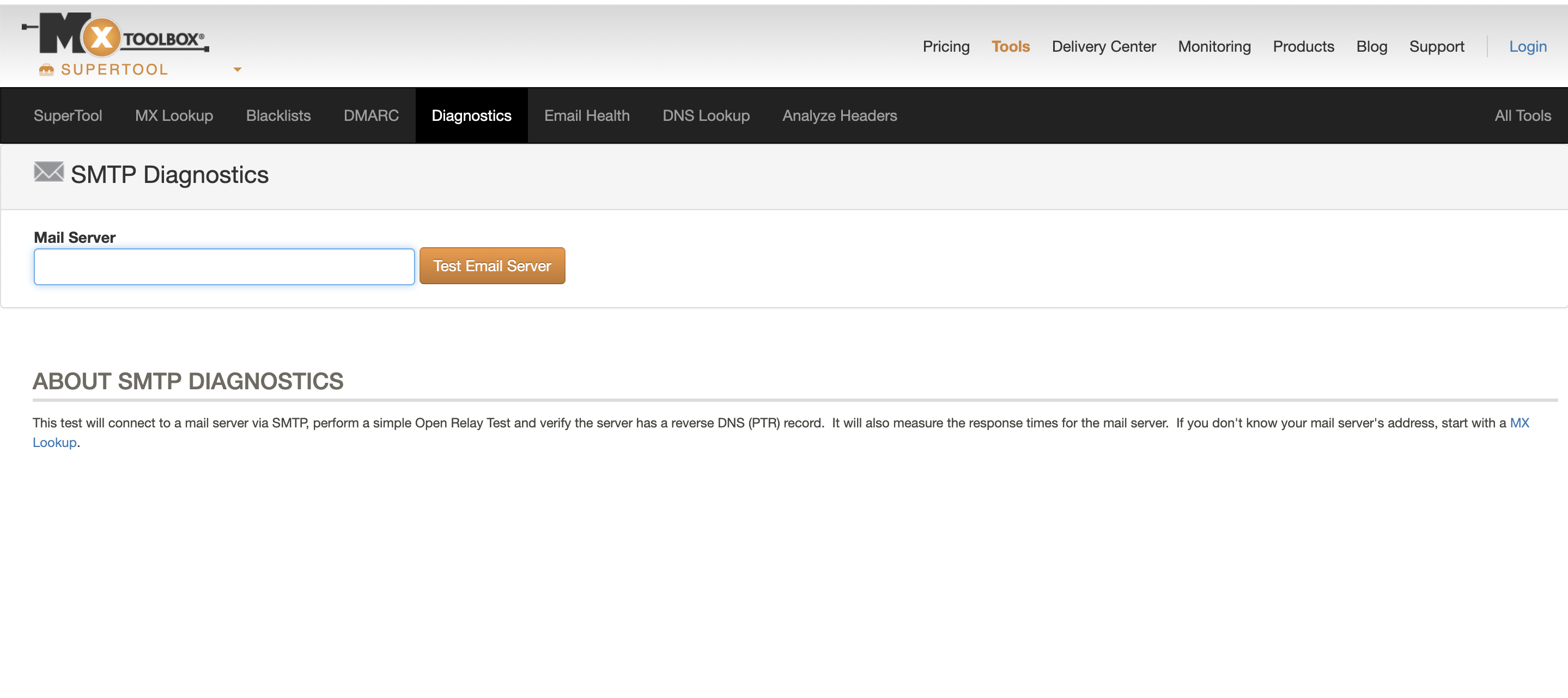
MxToolbox is a well-known name in email testing and monitoring. Its tool analyzes the headers, the blocklist reputation of your outbound IP address, and your SPF records. It then generates a comprehensive deliverability report, providing you with a wealth of useful information that you can closely analyze and use to improve the performance of your marketing campaigns. Free users are limited to one free monitor with access to the top 30 blocklists, so consider upgrading to the paid plan if you’re interested in access to multiple monitors and more blocklists.
4. Spam Check by Postmark
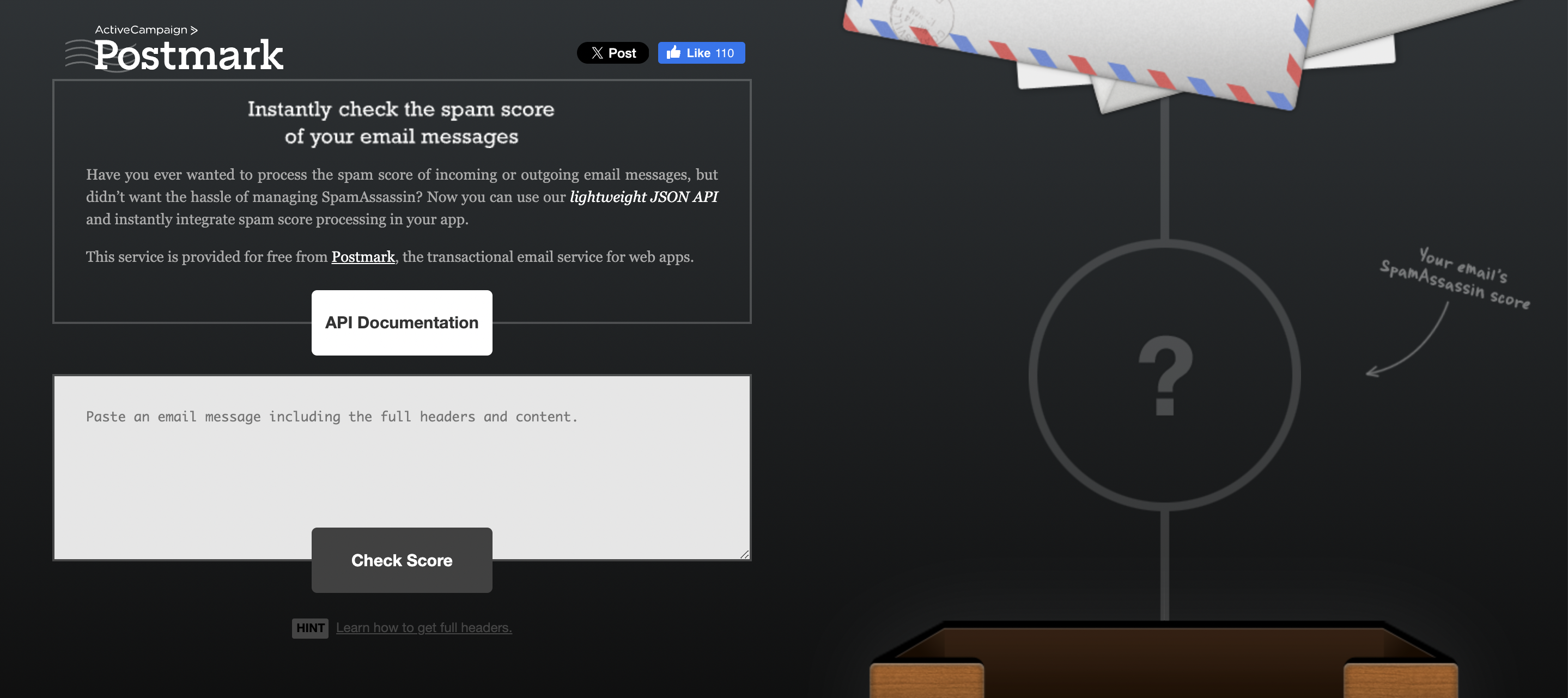
Spam Check by Postmark is an easy-to-use online tool that instantly checks your messages' SpamAssassin spam score. It is an open-source spam checker that uses various spam-detection techniques to separate spam from legitimate emails.
Many service providers use SpamAssassin. So, knowing how it sees your messages is beneficial in determining their deliverability. What’s great about Spam Check by Postmark is that you can simply paste a message, including its full headers and content. No need to send it anywhere.
5. GlockApps
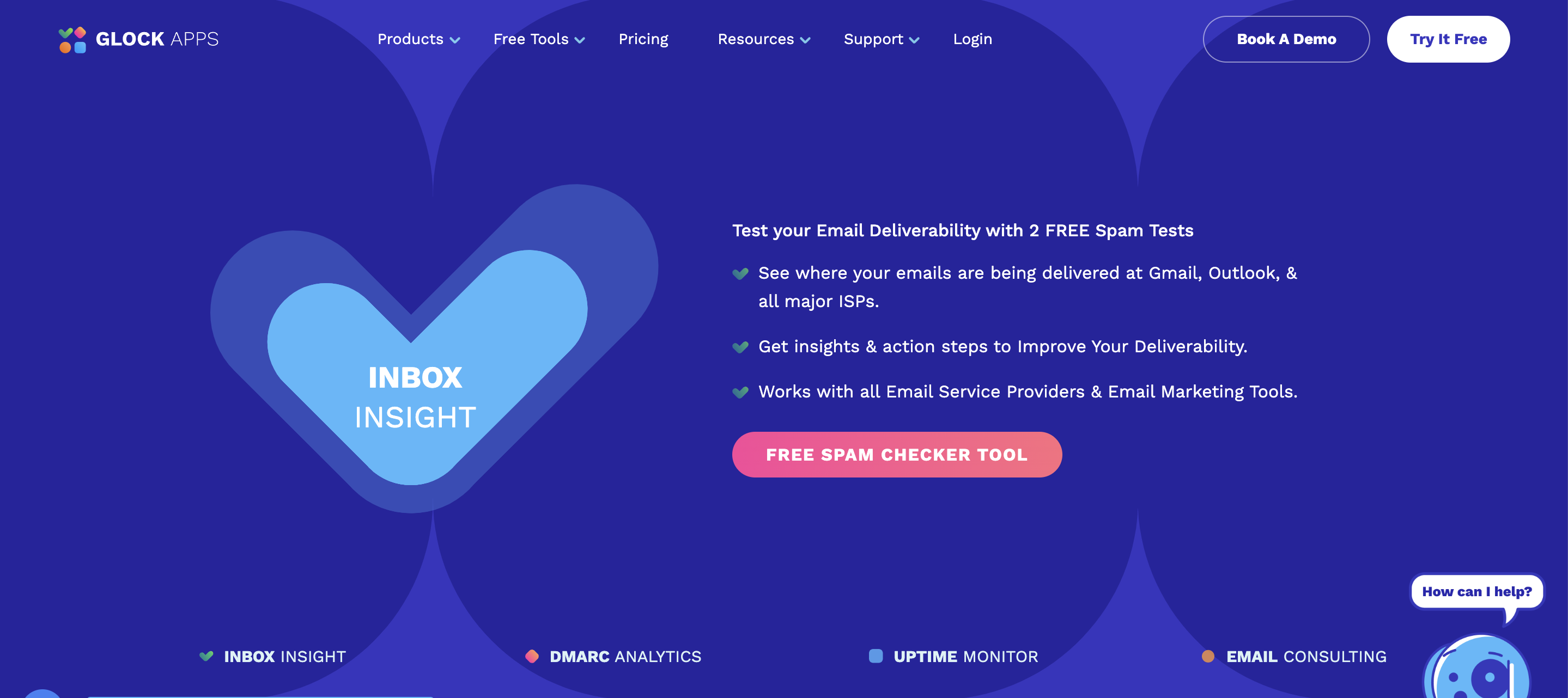
GlockApps is a full-featured service that offers everything you’ll need to maximize inbox deliverability:
- Email deliverability tester
- Blocklist monitor
- Spoofing detector
- HTML error checker and more
These tools perform virtually all checks marketers use, including sending your IP and domain information against more than 50 industry blocklists and tracking if your content or IP is blocked by:
- Gmail
- Yahoo
- Other ISPs
Thanks to the integration between the two services, all MailChimp users will appreciate that GlockApps can easily test their marketing campaigns directly from its website.
6. SendForensics
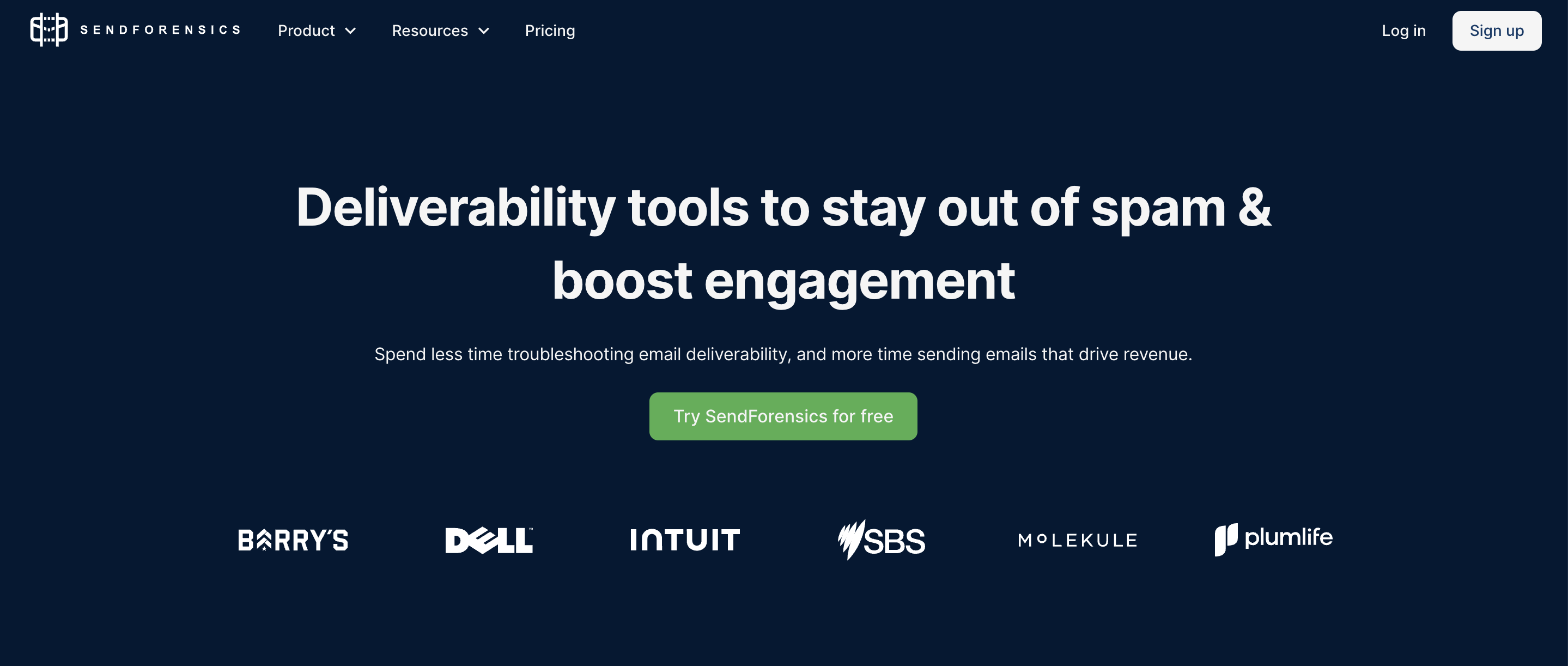
If you’re interested in generating detailed deliverability reports, check out SendForensics. This tried-and-tested email deliverability checker highlights the issues that send your emails to the spam folder by performing pre-emptive email deliverability testing and real-time scoring for live sends.
You can compare your rate with industry and regional benchmarks to know how well you’re doing and set alerts to quickly discover emerging issues before they become huge problems that can potentially ruin your marketing campaign.
7. Mailtrap.io
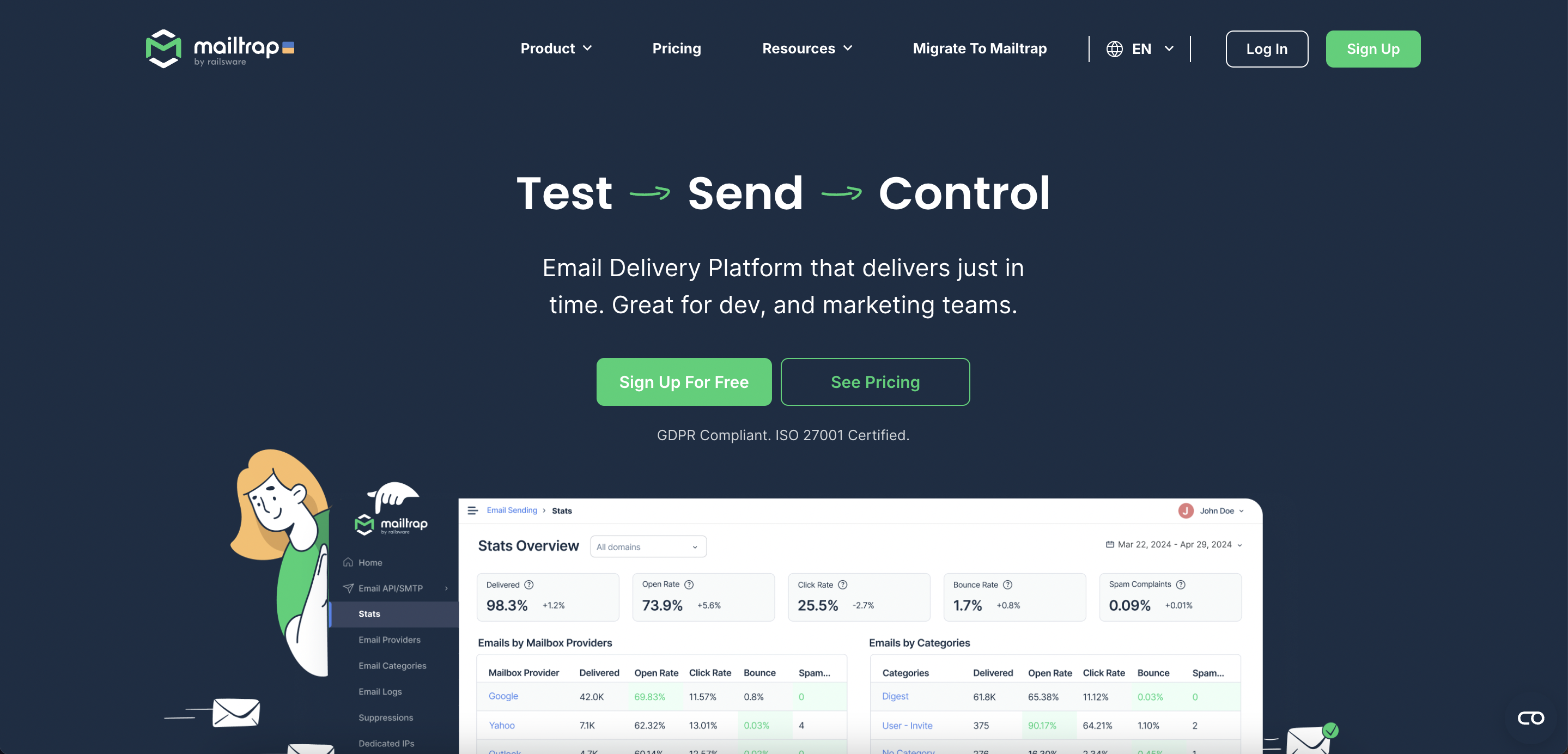
Mailtrap is an email testing tool that allows you to run numerous email experiments in a safe testing environment. It captures your test emails and provides options for inspecting and debugging your templates. With Mailtrap, all your email tests are neatly organized in one place and can’t be sent to real subscribers by mistake.
8. Saleshandy
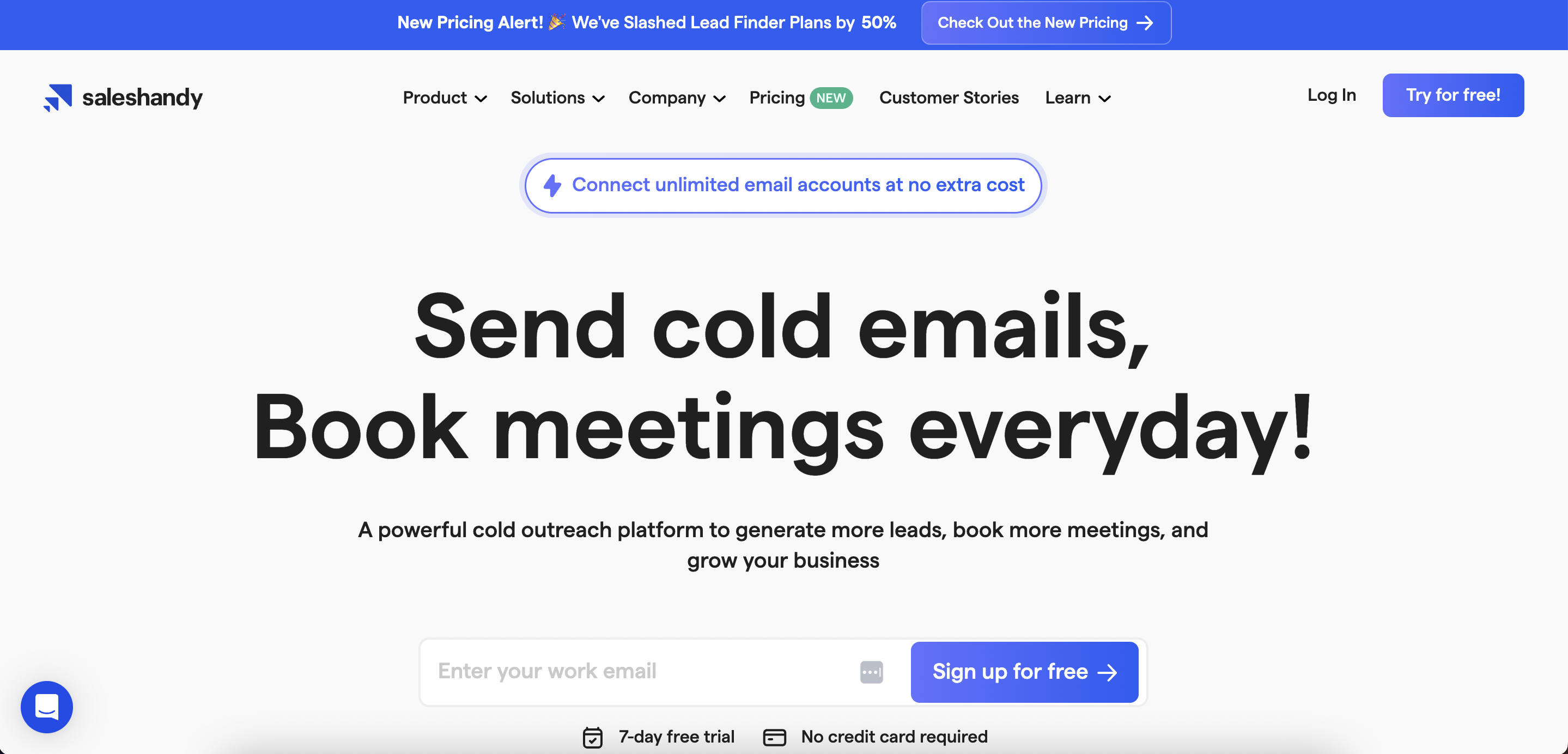
Saleshandy is your one-stop solution as an automated cold email outreach tool. With its advanced features, it makes sure your emails always reach your prospects’ inboxes. All email deliverability is mainly targeted at ensuring the message reaches the prospects; that is exactly what Saleshandy will do for you.
9. MailGenius

MailGenius is also a comprehensive email deliverability service that can help you improve your email deliverability score. Its advanced algorithms set It apart from other tools.
Using these algorithms, MailGenius can instantly identify potential issues in your emails that might trigger spam filters or cause emails to be flagged as junk. That means when you leverage MailGenius’s insights, you can optimize your email content and increase your email deliverability rate.
10. Everest -Validity

Everest is a product of Validity. While Validity provides many tools, we cannot ignore Everest when discussing email deliverability. While all the other tools talk about improving your email deliverability, Everest goes 1 step ahead and shares your competitor’s intelligence. The only catch is that this feature is only available in their most premium plan (Enterprise).
11. Google Postmaster Tools
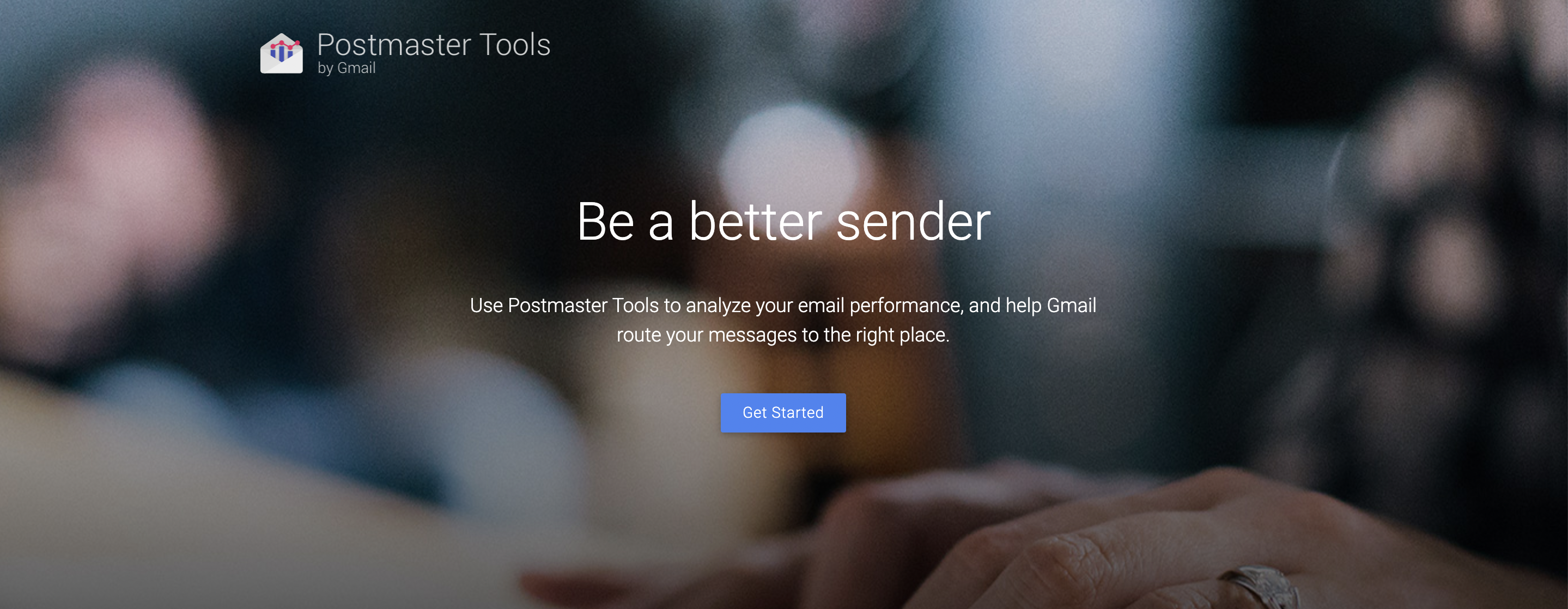
If you want to gain valuable insights into how your emails are being received and treated by Gmail’s systems, Google Postmaster is a must-have tool. Using this tool, you can quickly identify potential issues and make informed adjustments to ensure your messages are connecting with recipients’ primary inboxes every time.
Simply put, Google Postmaster can work as a feedback loop to understand how Gmail views your email traffic and what might affect your email deliverability. When you use Google Postmaster Tools before sending emails, you can see many important metrics, such as:
- Spam rates
- Domain reputation
- IP reputation
- Feedback loop results
12. Folderly
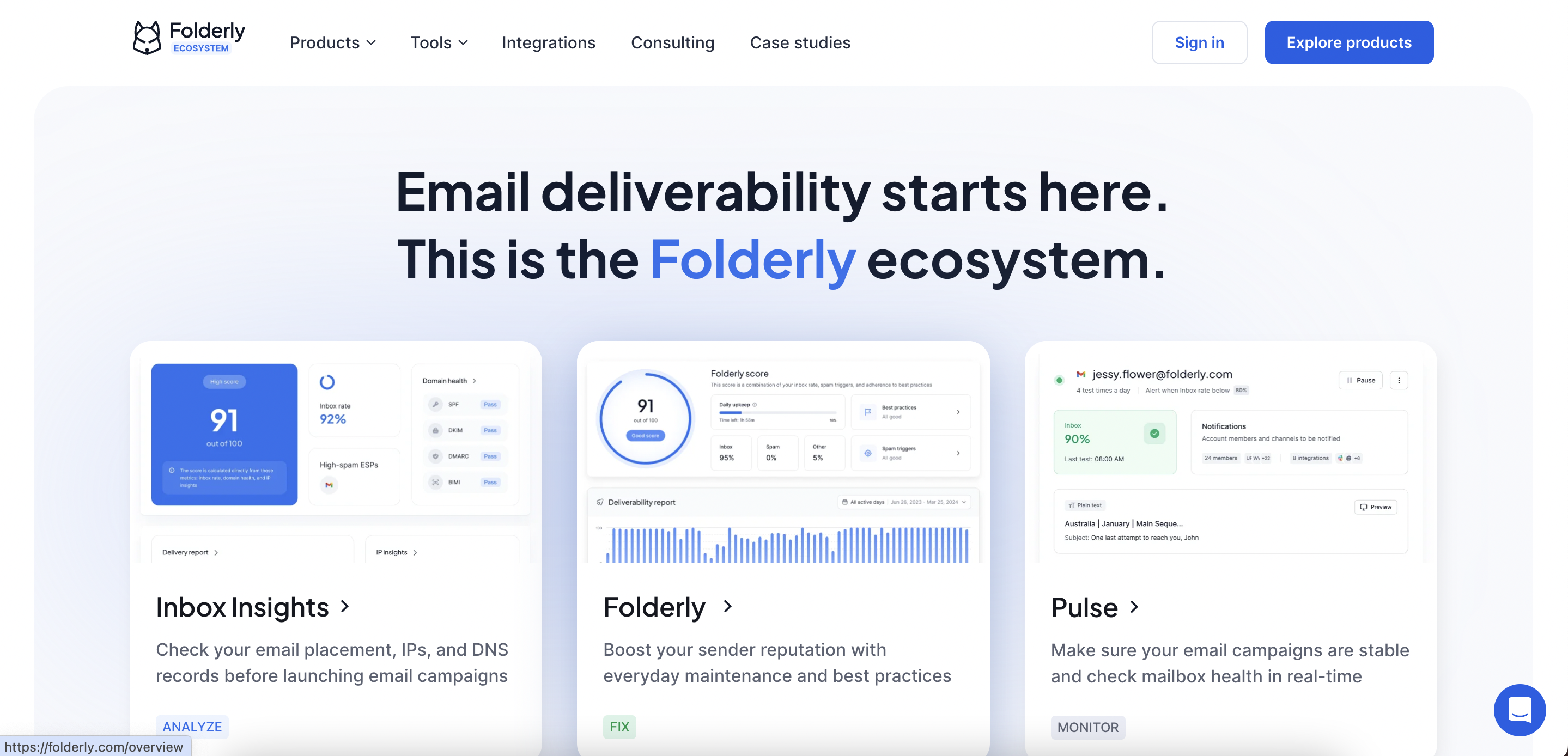
Folderly is the user’s choice for email deliverability due to its features like:
- Advanced detection
- In-depth analysis of DNS records
- Content checkups and more
This works with certified compliance software and customized support according to your campaigns. While searching for free email deliverability tools, users come across these free deliverability tests offered by Folderly that save them bucks. The list includes tests such as:
- Email spam checker
- SPF generator
- DMARC generator
- An email revenue calculator
13. Inboxally

The last tool on our list of best email deliverability tools is InboxAlly. InboxAlly’s main focus is helping you improve your sender’s reputation and optimize your email delivery strategies so that your email campaigns achieve your desired goals. The tool basically interacts with your email list and stimulates genuine engagement activities. These activities generally include opening your emails, marking them as necessary, and even moving them from the spam folder to the primary inbox.
14. UnSpam.email

Unspam.email is more like those email testing tools that you can use to test your email deliverability as a part of deliverability services. That means you can find out if your emails will likely be marked as spam or successfully reach primary inboxes, allowing you to make necessary adjustments to improve deliverability.
15. Mailchecker
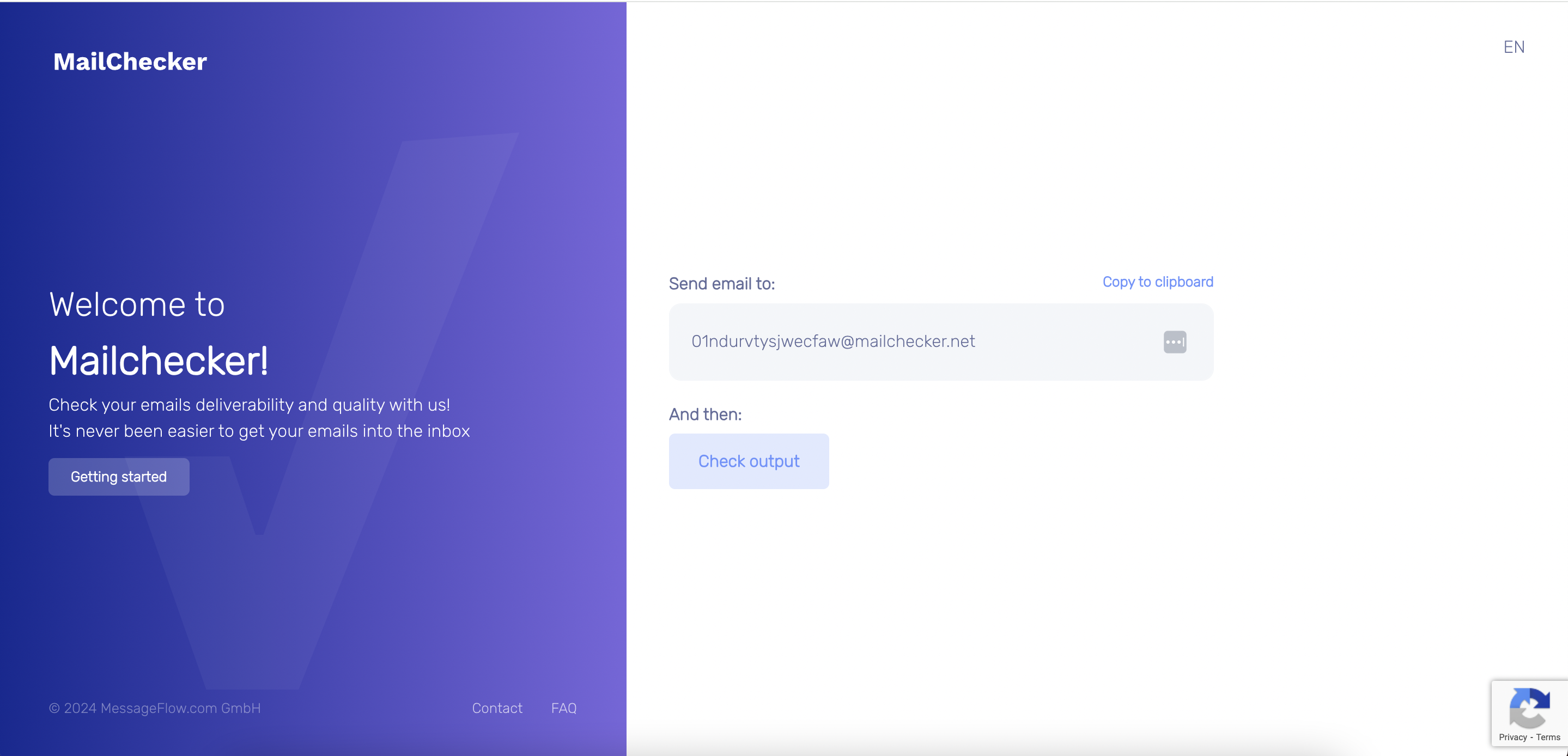
We wanted to add Mailchecker, a small tool for checking and testing, for users who do not want full-fledged email deliverability solutions but rather just a few tests. Well, not a small tool. It provides a good list of tests and reports based on email address analysis. It includes blacklist checking, authentication reports status, spam words flagging, and more crucial data points expected out of best email deliverability tools.
39 Ways to Avoid Sending Spam Email & Improve Email Deliverability

1. Start With a Pristine IP Address
You can improve your email deliverability by starting with a pristine IP address. Internet service providers (ISPs) use spam filters to protect users from unwanted emails. When you begin sending marketing emails, these filters will check your sender's reputation to determine if your messages are worth delivering to the user’s inbox.
Start Small and Gradually Increase Email Volume
The best way to boost your reputation with these filters is to send your emails to a small group of subscribers first. Ideally, you want to pick a group of recipients you know will engage with your emails. The ISP will gradually trust your IP address as they open and interact with your messages. Over time, you can increase the volume of your email sending until you reach your goal.
- Register a Subdomain and Use It Only for Email Activity
Instead of sending your email marketing campaigns from the same domain as your website, consider creating a subdomain exclusively for email marketing purposes. Over time, users will come to trust the subdomain, which is an added benefit.
The real purpose, however, is that this subdomain will allow for domain-specific monitoring of your IP reputation and be able to succeed against some domain-based certification filters.
3. Implement a Sender Policy Framework
A sender policy framework (SPF) increases your trustworthiness in the eyes of the receiving email server. The server can cross-check the domain name against the associated IP address to ensure it is legitimate. If you don’t have an SPF, your emails might be rejected.
4. Check Your Sender Reputation
The biggest reason your emails are not delivered is a low sender score. ISPs automatically reject any emails that fall below a certain score. Return Path produces Sender Score, Which assigns a number to every outgoing mail server. The score is calculated using traditional email metrics such as unsubscribes and spam reports.
5. Check Feedback Loops
Most major ISPs provide feedback loops in which the email sender can gain information from the recipients who have complained about that sender’s email. These are called Complaint Feedback Loops or FBLs. Yahoo, AOL, and Microsoft make it easy to get this information. Gmail allows users to set a Feedback Loop header that does not use the traditional ARF format of most FBLs. Only ESPs (email service providers) are allowed entry into Gmail’s FBL program.
6. Stick to a Consistent Send Schedule
One cause of a lower sender score and IP rejection is random and erratic broadcast activity. If you do not maintain a regular schedule with your emails, this can create sending spikes. Do your best to stick to a consistent email-sending schedule.
7. Use a Double Opt-In or Confirmed Opt-In
The most popular form of opt-in is the single opt-in, in which the user agrees to receive an email by simply checking a box or leaving the pre-checked box checked. This might seem like a great strategy to harvest email addresses since it’s so easy and automatic. Nevertheless, it can backfire by generating high amounts of spam complaints.
Prevent Spam Complaints with Double Opt-in
Spam complaints are dangerous. Some ISPs begin to block sending servers after as few as two or three spam reports per one thousand emails. The best way to defend against spam complaints is to use a double opt-in. All you do is send a confirmation email to the new subscriber asking to validate their address and gain their consent. (In some European countries, double opt-in is now mandatory.)
8. Purge Your List
If you send your marketing emails to non-existent users, you’ll ramp up your bounce rate and destroy your credibility. Now and then, remove all inactive recipients from your list, filtering out all users who have not opened or clicked your emails in a few months. High hard bounce (invalid) rates are the fastest way to trigger filtering and blocking on your IP.
You can use a paid service to clean all hard bounces before you launch a fresh email marketing effort. Most email validation services can catch:
- Duplicates
- Typos
- Outdated domains
- Do-not-email records
- Bogus addresses
- Other common user errors
You won’t lose anything by cutting the dead weight from your list.
9. Filter Contest Entry Email Signups
The worst email lists are created from giveaways or signups. True to their nature, people will attempt to enter multiple times using invalid or nonexistent email addresses. They don’t care about getting on your email address list but about a chance to win a free iPad mini.
If you use a contest or giveaway to gain email subscribers, you must vet this list thoroughly before dumping it into your subscriber list. It could be a source of hard bounces, landing you on the IP naughty list.
10. Send Emails at Just the Right Frequency
Too many emails can burn your subscriber list. Too few emails can kill your revenue. So what do you do to maximize deliverability? You send just the right number of emails. You can only find that perfect number by thoroughly testing, which isn’t easy. Plus, it takes a long time, and you might make some mistakes.
Finding the Optimal Email Frequency for Your Audience
A good benchmark is one email per week. You can try scaling up to twice weekly if you have excellent content. You can even drop back once a month without losing touch with your audience. But if you go anywhere outside of those two boundaries, you’re in dangerous territory.
11. Use Branding in Your “From” Name
Using your brand’s name in your “from” line will help to reduce spam complaints. It’s also been proven to improve open rates. Increasingly, some companies use a front person, an individual, to head up their email marketing to give it a more personal feel. You can still use this approach. Add “from [business name]” after the individual’s name.
12. Check Blacklists
If you’re experiencing send problems, or even if you’re not, it’s a good idea to check the blacklists. These DNS-based blacklists are created to protect users from IPs that have received a high volume of spam reports. Make sure that your IP is not on this list.
13. Reengage the Less-Active Contacts
In evaluating your recipient engagement, you might have identified subscribers who’ve only recently become inactive. For example, people who haven’t opened or clicked on your emails in the last three months. Since this group still has business potential, you should try winning them back.
Win-Back Campaigns: A Last-Ditch Effort
The most popular way of doing this is to run a win-back campaign. This can be done manually or automatically. Irek Rybinski suggests the following approach:
- Reengagement campaigns should be treated as a Hail Mary pass
- The last attempt to get your recipients back
- If it fails, they’re gone
There are three key factors that you need to take into account here:
- Timing
- Form
- Incentive
Timing depends mainly on your sending schedule. The more often you send, the shorter I should wait with my re-engagement. For example:
- I shouldn’t wait longer than 3 months if I send once a week.
- If I send it once a month, I can wait as long as an entire year.
The ideal option here is a triggered personal email. Using the same example above, the day my inactive contact reaches three months without action, they automatically get a reengagement email. If I can’t set that up, I should run a reengagement campaign every three months for all inactive contacts.
Of course, if they still fail to engage, I should remove them from my list. As for the form, there are several different approaches. I suggest making a big change in the content. This is the one message that should stand out from the rest. It should be unique enough that your contacts automatically see that they received something different from my usual sendout.
Here are some ideas:
- Go with a different email template and ask “were you waiting for a change?”
- Adapt my existing template but send it as a personal email from my staff member.
- Send a message titled “Is this a goodbye?”
- Give my contacts a chance to change their mind.
14. Partner Up with a Reliable Email Service Provider (ESP)
If you’re serious about improving your sender reputation and email deliverability, you’ll want to partner with a reputable email marketing software provider. If you’re not sure whether your current platform is the right one, check if it:
- Has relationships with all the major Internet Service Providers.
- Feedback loops have been set up with all the key mailbox providers.
- Automatically handles bounces, unsubscribes, and spam complaints.
- Does not allow its users to upload purchased or scraped lists.
- Participates in all major ISP industry initiatives to prevent spam, like MAAWG, EEC, and ESPC.
- Is compliant with all the major regulations such as CanSPAM, CASL, GDPR, and CCPA.
- Lets you authenticate your custom mailing domain.
- Authenticate your emails with SPF and DKIM.
- Has robust Deliverability and Compliance Teams onboard.
- Uses IPs with high reputation.
- Uses AI to identify potential email deliverability issues.
- Provides you with the Data Processing Agreement.
- Has servers in the country you’re most interested in.
- Ensures all your data is safe and secure.
- Regularly updates its tools to adapt to the latest industry standards.
- Has a good and established reputation on the market.
15. Give Your Recipients a Choice
Here’s another way you can decrease your email list churn and improve email deliverability: Give your subscribers a choice! Marketers have long known they should personalize their customer experience, but they rarely do that regarding the frequency and content of their email campaigns.
Give Subscribers Control with Preference Centers
If you want a better experience than most email marketers, consider creating a preference center or including extra checkboxes in your web forms that let your contacts express their mailing preferences. You could also include it on your unsubscribe page so that your customers can opt in rather than out of your email subscription.
This step may seem difficult to implement and maintain, but it can help keep your customers engaged longer. Plus, it gives them the sense that they’re in charge, which can, in turn, improve how they perceive your brand.
16. Make Unsubscribing from Your List Easier
This may sound counterintuitive, but the fact that people are unsubscribing from your list isn’t a big problem. Why? Because that means they’re receiving your emails; they’re just not into them. The problem starts when they’re not unsubscribing but filtering your messages into the spam folder. The situation is slightly more complicated when managing spam complaints because it requires changes in multiple places.
- I should review my subscription process and ensure everything’s transparent and clear. My contacts must fully understand what they’re signing up for and what content I’ll send them. I should add this information to my landing pages, web forms, thank you pages, and email footers. I’ll need to make unsubscribing from my list more manageable. In most cases, it’s enough if the unsubscribe process doesn’t require additional steps, like logging into my platform, and the removal link is easily found in my emails.
Prioritize Unsubscribe Links for Deliverability
In extreme cases, I may bring my unsubscribe link to the above-the-fold section—maybe even into the preheader. This may not seem ideal from a marketer’s perspective. But if I consider that each spam report affects my deliverability for that specific campaign and in the future, having more unsubscribes doesn’t sound like such a bad idea.
17. Implement Double Opt-In
The debate around double opt-in vs. single opt-in has been ongoing for years. It comes down to this: If you use double opt-in, you’ll get a higher quality list, but it’ll be smaller. From what we’ve seen, you may see roughly 30% fewer subscriptions.
Weighing the Pros and Cons
While single opt-in leaves you with more contacts to reach out to, the chances are that people signing up won’t be as engaged. So, how should you go about this? Do the math. But keep this in mind: Based on the results we publish in the Email Marketing Benchmarks report, industries where double opt-in is the most popular get the highest email engagement rates.
When to Use Double Opt-In for Your Email List
Using double opt-in is recommended if you’re experiencing deliverability issues or you’re seeing a significant number of bots signing up through your web forms. Double opt-in will also keep your list clean of:
- Spam traps
- Emails containing typos
- Temporary email addresses
If anyone ever asks how you collect email consents, double opt-in gives you additional proof that your contacts have made a deliberate decision to join my list.
18. Adjust Your Email Frequency
Email frequency plays a big role in building high customer engagement and deliverability. Here’s why: If you haven’t contacted your subscribers for a long time and suddenly sent them an email blast, they may take your message as irrelevant or unsolicited. And that can lead to high spam complaint rates.
Finding the Right Email Frequency
If, on the other hand, you’re sending too many emails, your recipients may feel overwhelmed and annoyed. If I’m lucky, they’ll unsubscribe. They’ll filter out my messages or report them as spam if I'm not. In other words, both too-quiet and too-busy communication schedules are bad. So how often should you email your subscribers? Sadly, there are no golden rules for that.
Data-Driven and Customer-Centric Approaches to Email Frequency
There are a few ways I can find the right email frequency. Some are more scientific and focus on maximizing conversions. Others involve asking your customers for feedback or allowing them to manage their mailing preferences, as discussed in #6.
19. Get a Dedicated IP Address
You probably use a shared IP solution if you send your marketing emails using email marketing software. While for most marketers, that’s the right approach, there are some downsides to it, too. For marketers with smaller email lists, a shared IP solution gives more flexibility and stable deliverability.
The Risks and Benefits of Shared IP Addresses
For example, they don’t need to be as careful about their email schedule or engagement rates. That’s because the IP reputation is built by all marketers who use these IPs to send their emails. At the same time, if some inconsiderate marketers also use these IPs, their behavior may affect the deliverability of everyone else using the same IPs to send their emails.
Understanding Dedicated IP Addresses
Naturally, the platform Compliance and Deliverability Teams are there to prevent and fix things like that. But there’s always a risk and you need to be aware of. An alternative approach is to use a dedicated IP address. This is usually reserved for bigger senders, with substantial email lists (i.e., 100,000+ records) and a regular communication schedule.
Choosing Between Shared and Dedicated IP Addresses
The main difference is that when you’re using a dedicated IP address, you’re the only one building its reputation. There are also some other differences between shared and dedicated IPs. If you’re a solid sender and know that your email deliverability could improve using a dedicated IP solution, you should look into it.
20. Improve Your Content
At the beginning of this article, we discussed how subscriber engagement affects your reputation and email deliverability. We suggested re-engaging and removing inactive contacts from your lists. But we didn’t discuss how to prevent my audience, or at least a percentage, from disengaging from my marketing emails.
One way to do this is to keep improving my email content. My emails should be:
- Interesting
- Engaging
- Valuable
Although it’s easier said than done, here are a few ways how I can make sure my email content continues to engage:
- I frequently use A/B tests to pick the most engaging subject lines, headlines, products, and articles in my messages.
- Ask my audience to provide feedback and suggest topics for future communication.
- Analyze the click-through data in my emails to select the best-performing calls to action (CTAs) and topics.
- Analyze the pageview data and time on page in my website’s Google Analytics reports to drive people to the best-performing pages.
Keep in mind that the best way to A/B test my emails is to:
- Test one thing at a time
- Run tests continuously and not ad-hoc
- Think of them as evolution not a revolution
This way, I’ll know what elements of my message made an impact, and I’ll give my recipients enough time to get used to the changes. The last thing you want to do is confuse those actively engaging with your communication.
21. Balance the Text-to-Link Ratio
You might never encounter this problem, but it’s worth mentioning in this guide. One of the things ISPs look at when evaluating email quality is the balance between the amount of text and the number of links.
Irek Rybinski explains it: “The text to link ratio needs to be reliable and relatable – providing good content value to your contacts. Sending them only clickable links is usually not one of them.”
The Importance of Link Quality for Email Deliverability
He also points out that link quality plays a role: ISPs will allow fewer links from a domain with a poor reputation that was already associated with abuse mailing than they would for a domain with a good reputation. Moreover, there seems to be a limit even to the good ones! The rules are quite straightforward. Stick to a single link for a short message (a few lines of text) or one per paragraph.
Balancing Links and Calls to Action in Emails
As I worked out the filters, I noticed they had no issue recognizing blog or site updates (e.g., first paragraph of an article, or just the title with a link to full article). ISPs seem to be rarely punishing senders for these types of links (if they do, it’s usually a domain reputation issue), so if that’s your business, then you don’t have to worry! If I do advertise products to my list, I should take it easy on the calls to action. I would say that two well-placed links will do the job just fine.
22. Balance the Image-to-Text Ratio
When creating emails, you should also consider how much of your message is images and text. The more text, the better your deliverability. This doesn’t mean my emails shouldn’t contain images. That’s not feasible, and no e-commerce business would allow that. But my message shouldn’t include just one big picture and a footer. Think about this practice both from the ISPs' and the recipients’ perspectives.
The Importance of Text and ALT Text for Email Deliverability
Many people use mailbox providers that block images by default. People pay attention to their first impression; if all they see is a message with all its content blocked, they’re not encouraged to open that message. That’s why having text in my emails (and ALT text for images) can help me improve my engagement and deliverability rates.
Balancing Images and Text in Emails for Optimal Results
Here’s what Irek Rybinski suggests: In the same way the link ratio matters, ISPs also look at the ratio between images and text. This seems to be more of a space-ratio kind of thing. The recommended dimensions are usually given in the 60%-40% or 70%-30% ratio (in favor of text). Nevertheless, I’ve seen emails going for 50-50 doing quite well, so I wouldn’t swear by just one value here. This is something that you need to test yourself.
23. Identify Yourself and Your Content
It all boils down to this: People open emails that seem interesting, valuable, and entertaining. They also look at who the sender is—whether they’re trustworthy, reputable, and knowledgeable. You need to focus on all those things throughout the entire customer journey. You don’t want my subscribers to feel disconnected when jumping from my Facebook page to my website and email subscription.
Maintaining Consistency in Your Email Sender Information
Here are a few best practices for you to keep in mind: Don’t change the from name and address used to send my emails too often. Have a consistent brand identity across all my marketing channels. Keep my email layout changes subtle so that people recognize it’s me. If I’m a solopreneur, there’s also one more thing I could try: send emails using my own name instead of the brand name.
Building Personal Connections Through Email
The hypothesis here is that people are more likely to build a bond with a person rather than a fictional brand. This strategy can only work if I follow through with it and don’t just use it on occasion. If I succeed with this step, my audience will engage with my communication more, improving my deliverability.
24. Run a Reconfirmation Campaign
If all else fails, there’s one more solution called reconfirmation. Reconfirmation campaigns are similar to reengagement programs, with one major exception. After you’ve run a reengagement campaign, you still get to decide what to do about those who haven’t responded to my emails. Although we suggest removing them from your lists entirely, you may try re-engaging them through remarketing ads or even calling them on the phone if you’ve got this kind of data. With reconfirmation campaigns, there’s no going back.
Re-Engaging Inactive Subscribers with a Single Email
Here’s how they work: You first identify the inactive contacts, then send them a single email asking if they’d like to opt in to my list. You’re not asking them whether they’d like to stay on my list, but instead, you’re asking them if they’d like to re-subscribe. After sending this message, anyone who doesn’t respond should be automatically removed from my database.
The Risks and Rewards of Purging Inactive Subscribers
I move those who respond to my active contact list and contact them to find out what caused them to become inactive for such a long time. This is by far the best solution for keeping your list clean. Naturally, it’s also risky, which is why so many marketers keep it as their last resort.
- Pro Tip: In your reconfirmation email, add information about how people can re-subscribe to my list after the link in the message expires. This way, if someone opens my message after some time, they’ll know what to do to keep getting my email updates.
25. Don’t Buy or Rent Email Lists
Yes, you can legally rent and purchase lists of people who have agreed to email communications, but it’s never a good idea. Not only is it a dirty email marketing tactic that goes against the Terms of Service for your email service provider, but these people don‘t actually know you, and it’s likely they won't even want your emails. In other words, there‘s a good chance they’ll mark you as spam.
26. Don’t Use All Caps Anywhere in Your Email or Its Subject Line
Using caps in email subject lines lowers the response rate by 30%. It looks like you are shouting at your audience, making your email less readable and disinteresting. It's annoying and can seem spammy. Instead of using disruptive tactics like all caps to get people's attention, try personalizing your emails and using catchy and delightful language.
27. Don’t Use Exclamation Points
Even the smallest of symbols can drastically change the destiny of your email. Using too many exclamation points seems unprofessional and dominating in a way. You don’t need any fillers to get your emails noticed. And when 69% of email recipients report email as spam based solely on the subject line, you'll want to avoid triggers like this as much as possible. Plus, asking for punctuation to do a word's job can really dilute your message. Use this flowchart as a gut check the next time you're tempted to use an exclamation point in an email (or anywhere).
28. Don’t Use Video, Flash, or JavaScript Within Your Email
Most email clients cannot view rich media like Flash or video embeds by default. As for JavaScript and other dynamic scripts, even if a spam filter allows your email to go through, most email clients won't allow these scripts to function. So, avoid using them altogether. Instead, use an image of your video player (with a play button) that links to the rich media on a website page.
Enhancing Your Video Idea with GIFs and Click-Through Tracking
If you want to communicate my video idea better, I can incorporate a GIF (with a link) and track the click-through rates afterward. To clear your doubts about embedding videos in emails, read our guide on embedding videos in emails.
29. Don’t Include Attachments to Your Emails
Yes, the statement sounds vague, but there are better ideas than including the attachments to your cold emails. An email with a short wall of text and all the first-hand information in the attachment could be left unnoticed. Also, the receivers consider the first emails with attachments as spam or malicious.
Avoid Spam and Improve Email Load Time with Attachments
This worsens the chances of getting your email to the spam folder. Upload the attachment to your website and link to the file location in your email using a practical call-to-action button. This will minimize the chance of being blocked by spam filters and decrease your email's load time.
HubSpot's attachment tool in the email editor automatically does this for you. Simply highlight a bit of text or an image and click the attachment icon, and HubSpot will turn that text or image into a link leading to that attachment.
30. Don’t Use Spam Trigger Words
One of the easiest ways to avoid spam filters is by carefully choosing the words I use in my email's subject line. A good rule of thumb is this: If it sounds like something a used car salesman would say, it's probably a spam trigger word. Think:
- Free
- Guarantee
- No obligation and so on
Instead of using these trigger words, be creative, interesting, and informative -- without giving too much away.
31. Don’t Forget to Use Spell Check
Spelling and grammar mistakes are the most embarrassing email offenses. According to a report by Grammarly, around 93% of the respondents made email typos and blunders. Of this 63% committed embarrassing typos, while the recipients misunderstood 50%. To maintain good email etiquette, you must avoid typos. And it‘s easy for little spelling mistakes to slip by, especially when you’re self-editing.
32. Don’t Jam Pack Your Email Copy with Keywords
Keyword-stuffing your emails means shoving as many keywords into your emails as possible. There‘s a reason Google gives a lower rank to web pages stuffed with keywords, and that’s because it's harmful to user experience.
To make it more likely folks will open my emails and not mark them as spam, write my emails for humans, not robots. Copywriting that makes people want to take action is both simple and compelling. To make my writing sound more personable and relatable, I can use:
- Casual language
- Colloquial expressions
- Personal anecdotes
33. Ask Your Subscribers to Add You to Their Address Book
Spam filters are more aggressive than ever, so much so that sometimes, the emails people value and want to read still end up in their spam boxes. Ensure your emails get delivered by telling the subscriber’s email server that your email is safe enough to end up in their inbox. Thrivecart does an excellent job of making this happen. They specify why adding their email address is essential for the subscribers.
34. Offer Recipients Both an HTML and a Plain Text Version of Your Emails
Plain text emails are simply emails void of any formatting, while HTML (HyperText Markup Language) emails use formatting that lets you design more beautiful emails with attractive visual components. By offering both a plain text and HTML version of a single email, you‘re indicating my legitimacy to ISPs and making my emails more reader-friendly.
Most email marketing tools will let you easily create plain-text versions within their email editor, so take those five extra minutes to make and optimize the plain-text version of your email.
- HubSpot customers: Learn how to create a plain-text email in HubSpot here. Also, ensure the HTML version is properly coded: If there are broken tags in my HTML, the email provider and users might mark it as spam.
35. Allow People to View Your Email in a Web Browser
Even after every step is taken to ensure proper email design, an email client can still display an email poorly. Each client displays emails differently. Every email client has certain features that may render only partially in other email clients.
How an email looks in Gmail might differ from how it looks in Yahoo or Outlook. Hence, it is crucial to view a link in every email as a web page.
36. Include Alt Text in Your Email Images
Many email clients block images by default. When someone opens my email, the images won't load unless they click a button to show them or change their default settings. Adding alt text to my images helps recipients understand my message even if they can't see the pictures.
This is especially bad if I use an image as a call to action. Without alt text, a “turned off” image will look like this: When I add alt text to the image, recipients will still know where to click to complete the action.
37. Keep Your Emails Short and Sweet
Too much copy is another red flag for spam filters. People generally like concise emails better. Everyone's busy, and their inbox is full, so why worsen things?
Writing like a human is one of the best ways to keep things short and sweet. Writing my email like I was talking to someone in real life makes it feel much more approachable and relevant. If I have to write a lengthier email, then break it into multiple paragraphs. Giving visual breaks and composing the email with a clear introduction, middle, and conclusion will make it much easier for your reader.
38. Test Your Emails Before Sending Them
There are many email clients out there these days that email marketers have to consider when creating emails. We also have to consider mobile users. After all, 41% of people read email on their mobile devices.
A/B Testing for Optimal Email Rendering Across Clients
Since different email clients view emails differently, I use the A/B testing technique to test my email copies. While it may be time-consuming to test my emails for all email clients, I'll want to test them for the ones my audience uses the most. If my email marketing tool allows me to preview what my email looks like in different email clients and devices that are popular with my audience.
39. Get an Email Sender Accreditation from a Third Party
Sender accreditation is a third-party process of verifying email senders and requiring them to follow certain usage guidelines. This badge of trust adds your company email address to a trusted listing that ISPs refer to allow certain emails to bypass email filters.
Related Reading
Use Our Email Template Builder for Free Today
Email marketing is a collaborative endeavor. Yes, the process starts with one person creating a strategy and drafting a message. But from there, it often involves multiple team members reviewing and approving content before it’s sent.
Blocfree makes this collaborative process more efficient by allowing teams to create and edit email templates. Users can easily share email templates with others to get feedback and make revisions so the process can go smoothly without hiccups.








